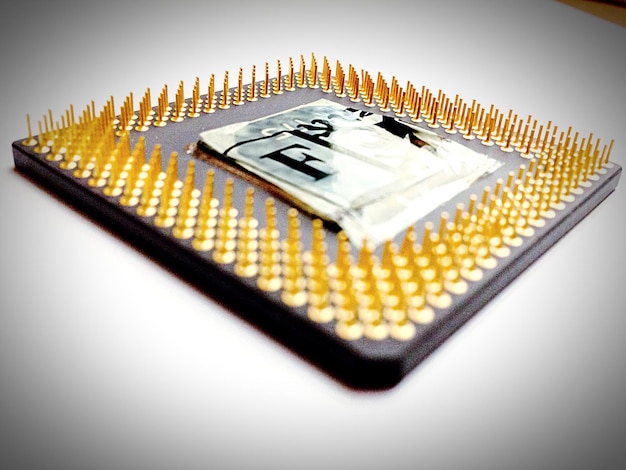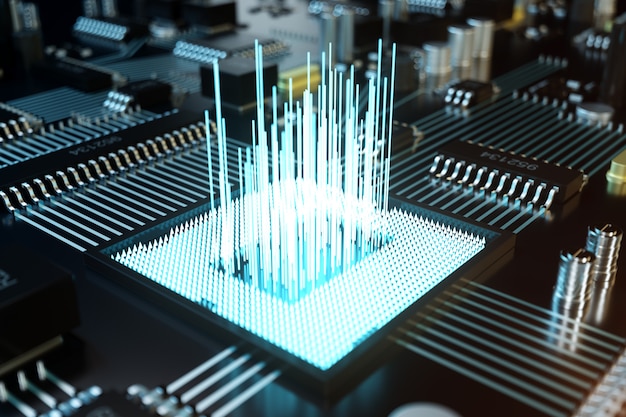Quick Read
Light-Based Chips: The Future of Energy-Efficient AI
Artificial Intelligence (AI) is revolutionizing various industries, from healthcare to transportation. However, the energy consumption of traditional AI systems has been a major concern. Enter light-based chips, which are poised to transform the landscape of energy-efficient AI solutions.
What Are Light-Based Chips?
Light-based chips, also known as photonic chips, are a type of semiconductor technology that uses light instead of electricity to process information. This innovative approach allows for significantly reduced energy consumption and increased processing speeds compared to traditional electronic chips.
How Do They Work?
Light-based chips utilize the principle of modulation instability, which allows for efficient conversion of electrical signals to optical signals. The chips can manipulate and process light in various ways, such as modulation, amplification, and wavelength division multiplexing.
Advantages of Light-Based Chips
The advantages of light-based chips are numerous. They offer lower power consumption, as they only require a small amount of electricity to generate and modulate light signals. Additionally, they provide higher processing speeds, making them ideal for applications that require real-time analysis and decision-making. Moreover, light-based chips offer improved data security, as optical signals are more difficult to intercept or hack than electrical signals.
Applications of Light-Based Chips in AI
Light-based chips hold immense potential for energy-efficient AI solutions. They can be used to develop advanced neural networks and deep learning models, which consume enormous amounts of energy in traditional electronic systems. Furthermore, they can be employed for optical computing, a groundbreaking technology that promises to revolutionize the way we process and analyze data.
The Future of Energy-Efficient AI with Light-Based Chips
The future of energy-efficient ai lies in the innovative use of light-based chips. These advanced semiconductor technologies offer significant improvements in power consumption, processing speeds, and data security compared to traditional electronic chips. As the demand for energy-efficient ai solutions continues to grow, light-based chips are set to become a game-changer in this exciting and rapidly evolving field.

Redefining Intelligence: Towards Energy-Efficient AI with Light-Based Chips
Artificial Intelligence (AI), a branch of computer science that aims to create machines capable of learning and reasoning, has been revolutionizing various industries with its ability to process complex data and generate insights. Energy consumption, however, is a major concern associated with AI’s exponential growth. With the generation of massive amounts of data and the computational processes required to extract meaningful insights from it, AI is increasingly becoming an energy-intensive technology. According to some estimates, data centers alone account for around 1% of the world’s electricity use. This not only contributes significantly to greenhouse gas emissions but also poses a major challenge in terms of scalability and affordability.
The Exponential Growth of AI and Data Generation
The Internet of Things (IoT), which refers to the network of interconnected devices, is generating vast amounts of data at an unprecedented rate. AI’s role in processing and analyzing this data is crucial for optimizing various applications, from predictive maintenance in manufacturing to autonomous driving in transportation. However, the computational requirements of AI algorithms, particularly neural networks, can be energy-intensive. Neural networks mimic the structure and function of the human brain to recognize patterns in data, but they require substantial computational resources.
The Promise of Light-Based Chips: A Potential Solution to Energy-Efficient AI
To address the energy efficiency challenge in AI, researchers are exploring alternative computing paradigms that can reduce the energy consumption without compromising the performance. One such promising solution is light-based chips. Also known as photonic computing or optoelectronic computing, this approach leverages light instead of electricity to process information. By using light waves to represent data and perform computations, these chips can potentially offer several advantages over their electronic counterparts:
Advantages of Light-Based Chips for Energy-Efficient AI
- Lower power consumption: Light can be transmitted over long distances without loss, allowing for more efficient data transfer and processing.
- Faster processing: Light can travel much faster than electrons in wires, enabling parallel processing and higher computational speeds.
- Greater scalability: Light-based chips can be designed to handle massive amounts of data simultaneously, making them ideal for AI applications.
- Reduced heat generation: Since light-based chips don’t rely on the flow of electricity, they generate less heat compared to electronic components.
The Future of Energy-Efficient AI with Light-Based Chips
The potential benefits of light-based chips for energy-efficient ai are significant, as they could enable large-scale ai applications with minimal environmental impact. While the technology is still in its infancy and faces several challenges such as complex fabrication processes and compatibility issues, ongoing research and development efforts are paving the way for commercial applications. The integration of light-based chips into AI systems could lead to a paradigm shift in how we process and analyze data, enabling more sustainable and efficient solutions for various industries.

Understanding Light-Based Chips
Light-based chips, also known as photonic chips or optical chips, represent a revolutionary approach to data processing that departs from the traditional silicon-based semiconductors we’re accustomed to. Instead of relying on electrons for information transfer and processing, these chips harness the power of photons, the elementary particles of light.
Definition and Explanation of Light-based Chips
Comparison to Traditional Silicon-based Chips: Silicon chips are the backbone of today’s digital world, but they have fundamental limitations. They rely on moving electrons around to process information, which can lead to significant delays and power consumption as signals travel through the chip. In contrast, light-based chips use photons – massless particles that travel at the speed of light – to transmit and process data.
Use of Photons Instead of Electrons for Data Processing: Traditional chips require the conversion of light signals to electrical signals and vice versa, which introduces losses and delays. Light-based chips aim to keep information in its optical form as long as possible, only converting it to electrical signals at the very end when it’s ready for output or input to other systems.
Key Components and Principles Behind Light-based Chips
Light Sources (Lasers or LEDs)
Light-based chips rely on light sources, such as lasers or light-emitting diodes (LEDs), to generate the photons that carry data. These devices produce light at specific wavelengths, making them crucial in designing and manipulating light signals.
Waveguides for Data Transmission
To transport the light signals, waveguides are used. These structures confine and direct the photons along a specific path through the chip. This allows for high-speed, low-loss data transmission and minimizes the need for conversion between optical and electrical signals.
Modulators for Processing Information Using Light
One of the most critical components in light-based chips is the modulator. These devices allow for processing information using light itself, enabling various operations such as amplification, attenuation, and routing of the light signals. This is achieved by manipulating the optical properties of the photons, making modulators a key element in enabling complex data processing with light.
Current State of Research and Development in Light-based Chips
Academic Research and Institutions Involved: Numerous academic research institutions, including universities and national laboratories, are investigating the potential of light-based chips. They focus on developing new materials, designs, and processing techniques to enhance their performance and applicability.
Companies Investing in This Technology: Major technology companies, such as Intel, Microsoft, and Google, are investing heavily in light-based chips research, recognizing their potential to revolutionize data processing and communication. They see this technology as a promising solution for addressing the limitations of traditional silicon-based chips and meeting the growing demands for faster, more energy-efficient computing.

I Advantages of Light-Based Chips for Energy-Efficient AI
Reduced energy consumption
Light-based chips offer several advantages when it comes to energy efficiency for AI applications. One of the most significant benefits is reduced energy consumption. This reduction can be attributed to several factors:
Fewer requirements for cooling systems due to lower heat generation
First and foremost, the lower heat generation of light-based chips results in fewer requirements for cooling systems. As AI systems become more complex and powerful, the need for efficient cooling solutions becomes increasingly important to prevent overheating and ensure optimal performance.
Elimination of Joule heating effect
Another factor contributing to the energy savings is the elimination of the Joule heating effect. This phenomenon occurs when electrical current flows through a conductor, resulting in wasted energy as heat. Since light-based chips do not rely on electrical signals for computation, they are able to eliminate this source of unnecessary heat generation.
Scalability and parallelism
Light-based chips also offer advantages when it comes to scalability and parallelism. These characteristics are essential for AI applications, which often involve handling large datasets and performing complex computations in parallel.
Ability to perform multiple computations simultaneously
The massively parallel architecture of light-based chips allows for the simultaneous performance of multiple computations, making them an ideal choice for AI applications. This capability not only improves processing speed but also enables more efficient use of resources.
Potential for faster processing due to massively parallel architecture
Moreover, the potential for faster processing through massively parallel architecture can lead to significant improvements in AI performance. This is especially important for real-time applications, such as autonomous vehicles or medical imaging systems, where quick decision-making is crucial.
Cost-effectiveness
Light-based chips also present several cost advantages, which can make them an attractive option for AI applications.
Lower production costs due to simpler fabrication processes
The simpler fabrication processes required for light-based chips result in lower production costs compared to traditional silicon-based chips. This cost savings can help offset the potentially higher upfront investment in developing and implementing these new technologies.
Potential for significant cost savings in the long run
Furthermore, the reduced energy consumption and increased processing power of light-based chips can lead to significant cost savings over time. By using less energy and performing computations more efficiently, these chips can help lower operational expenses for AI systems.
Faster communication between components
The use of light instead of electrical signals for communication in light-based chips offers several advantages, including faster data transfer rates and reduced latency.
Use of light instead of electrical signals for communication
By using photons instead of electrons to transmit information between components, light-based chips can achieve faster data transfer rates. This is because photons travel at the speed of light, whereas electrons travel much more slowly.
Potential for faster data transfer rates and reduced latency
The potential for faster data transfer rates and reduced latency can have a significant impact on AI performance, especially in applications that require real-time processing or large-scale data analysis. This could lead to improved accuracy and faster decision-making capabilities for these systems.

IV. Applications of Light-Based Chips in AI: The revolutionary
light-based chips
are paving the way for significant advancements in the field of artificial intelligence (AI). Let’s explore some of their applications and the potential benefits they bring to various AI domains.
Neural networks and deep learning
Light-based chips show great promise in
reducing energy consumption
for large neural network models, which is a significant concern given the immense computational power required to train them. Furthermore, these chips enable
faster training times
and improved performance due to their ability to process large amounts of data in parallel.
Machine vision systems
Machine vision systems stand to benefit significantly from the implementation of light-based chips. Their
enhanced image recognition capabilities
result from their real-time processing abilities, which can lead to improvements in edge AI devices.
Natural language processing
The potential applications of light-based chips in the domain of
natural language processing (NLP)
are equally impressive. They enable real-time processing of vast amounts of text data, leading to improved accuracy and
reduced energy consumption
in NLP tasks.

Challenges and Limitations of Light-Based Chips
Complexity of Designing and Manufacturing Light-Based Chips at Scale
Designing and manufacturing light-based chips at a large scale presents several challenges. One major issue is integration with current silicon-based infrastructure. Light-based chips use different physical properties and require specialized fabrication processes, making it difficult to seamlessly integrate them into existing systems. Another challenge is ensuring compatibility with existing software and hardware. Developers must adapt current algorithms, libraries, and tools to work with the unique characteristics of light-based chips.
Integration with Silicon-Based Infrastructure
Integrating light-based chips into the current silicon infrastructure necessitates significant redesign and modification of existing processes. This integration requires overcoming technical challenges, such as ensuring proper thermal management, electrical interfacing, and power delivery.
Compatibility with Existing Software and Hardware
The compatibility of light-based chips with existing software and hardware is another challenge. While some progress has been made in developing new programming languages and libraries, extensive efforts are needed to make these technologies accessible to developers and enable efficient integration with existing systems.
Limitations in Data Transmission Distances
Another major challenge with light-based chips is the limitations in data transmission distances. Transmitting light signals over long distances requires designing efficient methods to maintain signal integrity and minimize loss. One potential solution is the use of fiber-optic technology for improved communication, as it can transmit light signals over long distances with minimal loss.
Designing Efficient Ways to Transmit Light Signals Over Long Distances
Designing efficient methods for transmitting light signals over long distances is crucial for the widespread adoption of light-based chips. Techniques such as waveguide modulation, intensity modulation, and polarization multiplexing can help mitigate signal loss and improve data transmission rates.
Potential Use of Fiber-Optic Technology for Improved Communication
Fiber-optic technology, which uses light signals to transmit data over long distances through optical fibers, can provide a promising solution for improving communication with light-based chips. Integrating fiber-optic technology with light-based chips can enable efficient and reliable data transmission, extending the range of applications for these emerging technologies.
Compatibility with Existing Software and Hardware – Continued
Continuing with the topic of compatibility, another challenge is adapting existing AI models to work with light-based chips. Modifying current machine learning and deep learning algorithms for the unique characteristics of photonic computing is a significant undertaking. This involves not only updating the mathematical computations but also designing new hardware architectures to support these algorithms.
Adapting Existing AI Models to Work with Light-Based Chips
Adapting existing AI models for photonic computing requires extensive modifications at both the algorithmic and hardware levels. Researchers must develop new methods to represent data as optical signals, design new circuits for performing computations using light, and optimize algorithms for these new architectures.
Developing New Software Optimized for Light-Based Chips
Creating new software optimized for photonic computing is another crucial step in making light-based chips a viable solution. Developers must create new programming languages, libraries, and tools that enable efficient computation using light signals. This involves not only designing new algorithms but also rethinking the underlying hardware-software interfaces to effectively utilize the unique properties of light-based chips.

VI. Conclusion and Future Outlook
In conclusion, the advent of light-based chips holds immense promise for energy-efficient AI systems. These innovative components offer a myriad of benefits and advantages, including reduced power consumption, increased processing speed, and broad potential applications in various domains such as autonomous vehicles, healthcare, and financial services.
Collaboration is Key
Collaborative efforts between researchers in academia and industry will be essential for driving the development and adoption of light-based chips in AI systems. Academic research can provide the foundational knowledge and innovative breakthroughs, while industry partners can contribute resources, expertise, and real-world applications to bring these technologies to market.
Addressing Challenges
Despite the potential benefits of light-based chips, there are also challenges and limitations that need to be addressed for successful implementation in AI systems. One major challenge lies in the design and manufacturing of these complex components. Developing scalable fabrication processes will be crucial for mass-producing light-based chips that are both affordable and high performing.
Overcoming Integration Issues
Another challenge is the integration of light-based chips into existing AI architectures and platforms. Ensuring seamless compatibility with current hardware and software will be necessary for widespread adoption. Addressing these integration issues may require the development of new interfaces or modification of existing ones.
Ensuring Reliability and Durability
Reliability and durability
are also critical factors for the successful implementation of light-based chips. Ensuring that these components can withstand the demands and stresses of AI applications will be essential. Additionally, creating robust designs that are resilient to potential failures or malfunctions is crucial.
Long-Term Implications
The long-term implications of light-based chips in AI research and development are significant. With their potential for reduced energy consumption, improved performance, and cost savings, these components could revolutionize the way we design and build AI systems. As research in this area continues to advance, we can look forward to a future where energy-efficient AI is not just a goal but a reality.
